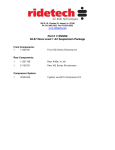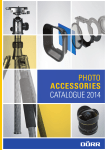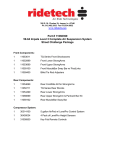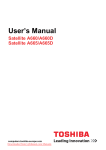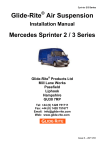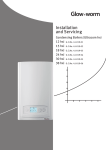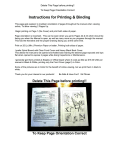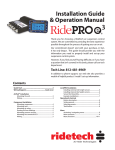Download STR2200 62-67 Chevy II & Nova Street Challenge Package
Transcript
350 S. St. Charles St. Jasper, In. 47546 Ph. 812.482.2932 Fax 812.634.6632 www.ridetech.com STR2200 62-67 Chevy II & Nova Street Challenge Package 1 SKW1016DA Front Double adjustable Shockwaves 1 ABAR20200DA Rear AirBar with Double adjustable 7000 series Shockwaves 1 APOD4000LE3 5 gallon AirPod w/ LevelPro control system 1 REM8500 Two key fob remotes with antenna 1 SWA7400 Front MuscleBar sway bars with mounting kit 1 Street Challenge Shirt 350 S. St. Charles St. Jasper, In. 47546 Ph. 812.482.2932 Fax 812.634.6632 www.ridetech.com SKW1016DA – 62-67 Chevy II & Nova Front Shockwave Double Adjustable 2 SKW1500 255 bellows 2 SKW2602DA 2.6” smooth shock (short Double Adjustable) 2 SKW013 internal bump stop 4 SKW1701CHA bead ring 2 SKW1751CHA 255 upper mount domed top 2 SKW1761CHA lower mount for 255 (with set screw) 4 SKW114 small o-ring 4 SKW228 large o-ring 2 SKW022 Nova lower trunnion 4 SKW015 trunnion snap rings 4 SKW051 poly bushing halves 2 SKW010 1 ¼” stud adapter 4 SKW007 polyurethane stem bushings 2 SKW021 upper Mount Plates 2 SKW020 lower Mount Plates 2 FIT4201 1/4 x 1/4 swivel elbows 4 7/16 SAE jam nuts upper stud 2 ½” X 1 ½” Fender washer upper stud 4 3/8” x 1 ¼” USS bolts 4 3/8” USS nyloc nuts 8 3/8” SAE flat washers 8 5/16” x 1” USS bolts upper plates 8 5/16” USS Nyloc Nuts 16 5/16” SAE Flat Washers trunnion to upper arm Installation Instructions for SKW1016DA Front Shockwaves 1. Raise and support vehicle at a safe, comfortable working height. Let the front suspension hang freely. 2. Remove the coil spring, shock absorber, upper shock mount, lower coil spring mount, and strut tower reinforcement plate. Refer to a factory service manual for proper disassembly procedure. The strut tower reinforcement plate will be reused. 1. Place the upper Shockwave plate on top of the strut tower. Temporarily secure the plate with two 5/16” x 1” bolts, nyloc nuts and a flat washer on each side. 2. With a 5/16” bit drill the two holes closest to the engine. 3. Remove the nylocs and hold the lower plate up to the bottom of the strut tower and finger tighten the nylocs. Drop the last two bolts into place then tighten all four bolts. 4. Apply thread sealant to the air fitting and screw it into the top of the Shockwave. 5. Push one of the bushings down over the stud with the step in the bushing facing up. 6. Hold the Shockwave up to the strut tower with the stud protruding through the upper plate. 7. Push the other bushing down of the stud with the step facing down. Cap it off with a large 1/2" fender washer and two 7/16” jam nuts. 8. Raise the upper arm up to the Shockwave and fasten the Shockwave trunnion to the upper arm using two 3/8” x 1 ¼” bolts, nylocs and a washer on each side. 9. Before reinstalling the strut tower reinforcement plate route the airline. 10. Double check air spring clearance through full suspension travel. 11. Driving pressure should be around 85psi, but will vary to driver preference and vehicle weight. The care and feeding of your new ShockWaves 1. Although the ShockWave has an internal bumpstop, DO NOT DRIVE THE VEHICLE DEFLATED RESTING ON THIS BUMPSTOP. DAMAGE WILL RESULT. The internal bumpstop will be damaged, the shock bushings will be damaged, and the vehicle shock mounting points may be damaged to the point of failure. This is a non warrantable situation. 2. Do not drive the vehicle overinflated or “topped out”. Over a period of time the shock valving will be damaged, possibly to the point of failure. This is a non warrantable situation! If you need to raise your vehicle higher that the ShockWave allows, you will need a longer unit. 3. The ShockWave is designed to give a great ride quality and to raise and lower the vehicle. IT IS NOT MADE TO HOP OR JUMP! If you want to hop or jump, hydraulics are a better choice. This abuse will result in bent piston rods, broken shock mounts, and destroyed bushings. This is a non warrantable situation. 4. Do not let the ShockWave bellows rub on anything. Failure will result. This is a non warrantable situation. 5. The ShockWave product has been field tested on numerous vehicles as well as subjected to many different stress tests to ensure that there are no leakage or durability problems. Failures have been nearly nonexistent unless abused as described above. If the Shockwave units are installed properly and are not abused, they will last many, many years. ShockWave units that are returned with broken mounts, bent piston rods, destroyed bumpstops or bushings, or abrasions on the bellows will not be warrantied. Adjusting shock valving The knobs on the Shockwave will adjust the dampening characteristics of the shock absorber. One knob is for compression and the other for rebound, they are labeled accordingly. There are 16 clicks per knob, 1 is located fully counter clockwise and being the softest setting. We recommend 1 click for every 10psi. This can be fine tuned to driver preference. 350 S. St. Charles St. Jasper, In. 47546 Ph. 812.482.2932 Fax 812.634.6632 www.ridetech.com ABAR20200 Chevy II Nova Rear AirBar SKW7000 Rear Shockwaves 2 SKW5001SA Smooth shocks (long) 2 SKW7114 Rear bellows with ends crimped on 2 SKW013 Internal bump stop 4 SKW114 ShockWave small O ring 4 SKW227 ShockWave large O ring 2 SKW047 Upper eye mount 4 SKW057 1/2" sleeves 8 SKW048 Poly bushing halves 2 FIT4201 1/4" x 1/4" swivel 90 fitting 1 SKW100 pair of AirCan’s AirBar Components 2 A660-1 Lower axle mounts 1 A661D-1 Lower shockwave mount 1 A661P-1 Lower shockwave mount 2 A108 Axle tabs 2 A646 Axle tabs 1 A665D-1 Upper bar mount 1 A665P-1 Upper bar mount 2 A659-1 Upper bar bolt plate 1 A662-1 Upper crossmember 2 BARTW7.375” Upper bars (C-C length 9.50”) 2 BARWW25” Lower bars 6 ROD302 Rubber bushings pressed into bars 4 DAYM02153 Poly bushing halves for lower bar 4 A664 Lower bar bushing sleeve 2 ROD1000 Upper bar rod end Hardware List 6 5/8 x 2 ¾ SAE Gr.8 bolts Bars to crossmember and brackets 6 5/8 SAE Gr.8 Nyloc Jam nuts 2 Square corner U bolts Upper crossmember to car 12 3/8 USS nyloc nuts Upper bar mount and crossmember 12 3/8 SAE flatwashers 4 ½ x 2 ¼ Gr. 8 SAE bolts Shockwaves to mounts 4 ½ Gr.8 SAE thin nyloc nuts 4 5/8 x 1 ¼ SAE Gr8 bolts Shockwave brackets to axle brackets 4 5/8 SAE nyloc nuts 8 7/16 SAE nyloc nuts U-bolts 1. Raise the vehicle to a safe and comfortable working height. Use jack stands to support the vehicle with the suspension hanging freely. 2. Support the axle and remove the leaf springs, shocks, pinion snubber, and tail pipes. Refer to the factory service manual for proper disassemble procedures. Keep the factory upper shock bolts and front leaf spring mounting bolts. 1. The pinion snubber mount must be cut on the line shown in the picture. This allows more clearance of the pinion for maximum drop. 2. Remove the gas tank sending unit wire from the tank and pull it into the trunk. 3. This raised area around the gas tank sending unit wire must be flattened to allow the upper bar mount to sit against the pan. The area marked in chalk can either be pie cut, hammered flat and welded back together or cut out completely. 4. The upper bar mount will bolt to the bottom of the car using the factory shock bolts and locates off the factory shock mount. Note: The bar mount will point towards the outside of the car. This is the passenger side. 5. Using the bracket as a template drill 4 7/16” holes through the pan. 6. The upper bar bolt plate can be dropped into place from the trunk. The bracket will be clamped into place using 3/8” nylocs and flat washers. 7. Lower the axle enough to slide the upper crossmember into place. The frame is wider towards the rear of the car as is the crossmember. Push it forward until it is tight between the frame rails, but make sure it is square. Drill two holes with a 7/16” drill bit. 8. Remove the crossmember and drop the 3/8” U-bolt through the holes. Reinstall crossmember and tighten with 3/8” nylocs and flat washers. Shown below: 9. Bolt the lower axle bracket to leaf spring plate on the bottom of the axle using the new 7/16” nylocs supplied. Do not tighten until the lower bar is in place. 10. Install the lower arm (the longer one) into the oem leaf spring hanger using the factory hardware. This is a polyurethane bushing and is lubricated at the factory with lithium grease. Any future lubrication can be done with any nonpetroleum based lubricant. 11. The other end of the lower bar will attach to the axle bracket using 5/8” x 2 3/4" bolts and nylocs. This is a rubber bushing and does not require lubrication. Do not tighten the bar bolts yet. 12. The lower Shockwave mount is bolted to the lower two holes of the axle bracket with two 5/8” x 1 1/2" bolts and nylocs The U shaped portion of the bracket will face toward the inside of the vehicle. 13. Bolt the axle tabs to the upper bar as shown in the picture. Then bolt the other end to the upper bar mount. Do not weld the tabs yet. 14. Before welding the tabs you must center the axle and set the pinion angle. This must be done at ride height. Raise the axle until the is 14 1/2" from center eye to center eye on the Shockwave mounts, this is ride height. One trick that we use to maintain the settings are to tack weld a 4” spacer between the axle and the frame. 15. How do you set the pinion angle? On a single-piece shaft you want to set it up where a line drawn through the center of the engine crankshaft or output shaft of the transmission and a line drawn through the center of the pinion are parallel to each other but not the same line. A simple way to do this is to place a digital angle finder or dial level on the front face of the lower engine pulley or harmonic balancer. This will give you a reading that is 90 degrees to the crank or output shaft unless you have real problems with your balancer. At the other end, you can place the same level or angle finder against the front face of the pinion yoke that is also at 90 degrees to the centerline. If you rotate the yoke up or down so both angles match, you have perfect alignment. Road testing will tell you if you have it right. If you accelerate and you get or increase a vibration, then the pinion yoke is too HIGH. Rotate it downward in small increments of a degree or two until the problem goes away. If you get or increase a vibration when decelerating, then the pinion yoke is too LOW. Rotate it upward to correct it. 16. Axle center is best determined by dropping a plum on the outside of the quarter panel and measuring into the axle. This must be done with the car level from side to side. 17. Once everything has been doublechecked you can tack weld the tabs the axle. After removing the upper bar from the tabs you can finish welding the tabs. This will prevent you from frying the bushings. 18. Reinstall the upper bar and snug all bar bolt with the axle still at ride height. The 4” spacer can now be removed. 19. A new 3/4" hole must be drilled for the sending unit wire. You can reuse the original grommet. 20. Apply thread sealant the air fitting and screw it into the top of the Shockwave. 21. The Shockwave will be secured into place with 1/2" x 2 1/4" bolts and nylocs. 22. Check clearance with brake lines, parking brake and vent tubes. 23. The exhaust can either be rerouted under the axle or a turn down can be installed. 24. Ride height will be around 80 psi with about 3-4 clicks. SKW 7000 1.750 1.375 Compressed Height Ride Height Extended Height 11.5” 14.5” 16.5” Ø4.00 2.625" WITH 10.66" SHOCK 3.375" WITH 11.56" SHOCK 5.00" WITH 13.50" SHOCK The care and feeding of your new ShockWaves 6. Although the ShockWave has an internal bumpstop, DO NOT DRIVE THE VEHICLE DEFLATED RESTING ON THIS BUMPSTOP. DAMAGE WILL RESULT. The internal bumpstop will be damaged, the shock bushings will be damaged, and the vehicle shock mounting points may be damaged to the point of failure. This is a non warrantable situation. 7. Do not drive the vehicle overinflated or “topped out”. Over a period of time the shock valving will be damaged, possibly to the point of failure. This is a non warrantable situation! If you need to raise your vehicle higher that the ShockWave allows, you will need a longer unit. 3. The ShockWave is designed to give a great ride quality and to raise and lower the vehicle. IT IS NOT MADE TO HOP OR JUMP! If you want to hop or jump, hydraulics are a better choice. This abuse will result in bent piston rods, broken shock mounts, and destroyed bushings. This is a non warrantable situation. 8. Do not let the ShockWave bellows rub on anything. Failure will result. This is a non warrantable situation. 9. The ShockWave product has been field tested on numerous vehicles as well as subjected to many different stress tests to ensure that there are no leakage or durability problems. Failures have been nearly nonexistent unless abused as described above. If the Shockwave units are installed properly and are not abused, they will last many, many years. ShockWave units that are returned with broken mounts, bent piston rods, destroyed bumpstops or bushings, or abrasions on the bellows will not be warrantied. Adjusting shock valving The knob on the bottom of the Shockwave will adjust the dampening characteristics of the shock absorber. There are 16 clicks total, 1 is located fully counter clockwise and being the softest setting. We recommend starting with about 3-4 clicks. This can be fine tuned to driver preference. 350 S. St. Charles St. Jasper, In. 47546 Ph. 812.482.2932 Fax 812.634.6632 www.ridetech.com APOD4100LE3 LevelPro AirPod Compressor System 1 5 gallon AirPod 1 CON8002 2 6-32 x 3/8” Phillips pan head screw for display 1 WIR3400 Display Harness 1 WIR8360 Height sensor harness (2 short – 2 long) 4 SEN001 Height sensor 10 Heat shrink tubes 4 SEN002 1 2 2 1 1 WIR External power harness 1 WIR5000 Fuse holder 1 WIR5040 40 amp fuse 1 #10 Yellow butt connector 1 #10 5/16” eye connector 2 ARL2000 30’ roll of ¼” airline 4 FIT4201 ¼”npt x ¼”airline fitting 1 Installation Guide RidePro E3 Display Hardware kit for height sensor (includes the following) Steel linkage rod Rubber rod ends ¼” sensor bolts w/ Nyloc nuts & flat washers Mounting tab















